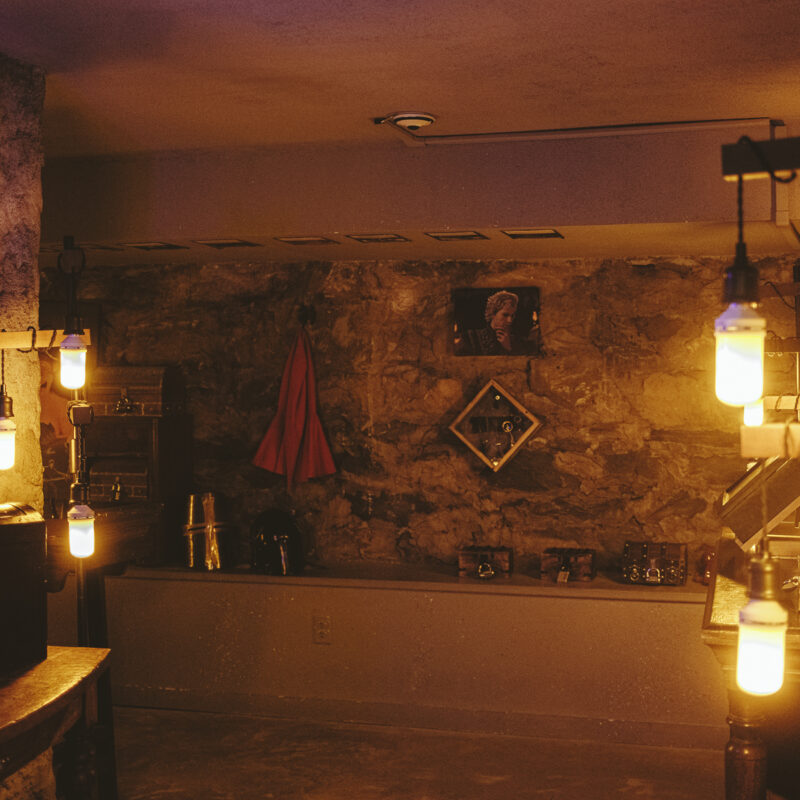I visited the UVA Art Museum last week intending to see the “Highlights from the Collection: From Rodin to Warhol” exhibit that was scheduled to open Friday. When I arrived I learned that the Bayly’s elevators were malfunctioning, which made it impossible for museum staff to tear down the last exhibit, “Treasures Rediscovered.” (Would you want to carry an unwieldy series of thousand-year-old Chinese statues down two flights of stairs?)
|
Janine Antoni’s “Conduit” is one of the edgy works now showing at the UVA Art Museum. The work is a photograph of the artist using a gargoyle-shaped prosthetic device that allows women to stand while urinating. The device is also on display in the museum. |
Defeated, I wandered into Janine Antoni’s “At Home in the Body,” displayed on the museum’s first floor. The exhibit’s centerpiece is “Tender Buttons,” named after the Gertrude Stein poem. At first the work appears to be a pair of earrings. But on closer inspection, “Tender Buttons” turned out to be gold casts of a woman’s nipples in an elegant velvet box. “Highlights from the Collection” didn’t seem so important anymore.
Antoni, whose work will be on display there through June, is a New York-based visual and performance artist. She was first widely recognized for 1992’s “Gnaw,” which consisted of two 600-pound blocks—one made of chocolate, the other of lard—that Antoni carved into abstract architectural forms using only her teeth. She used the leftovers to make heart-shaped boxes and lipstick.
“Tender Buttons” and “Gnaw” point to themes in Antoni’s work that are on full display at the museum. She blurs the lines between static and performance arts, and between artist, art and audience. “Conduit” is a prosthesis in the style of a gargoyle, designed to allow women to urinate while standing. The small sculpture is accompanied by a digital print of a woman using that tool to urinate off the top of a skyscraper, next to real gargoyles.
With urine, nipples, a cast of a kneeling woman draped in rawhide (“Saddle”), Antoni’s work feels very…dare I say edgy for the museum? It is the latest sign that the dusty redoubt so often ignored by passersby on Rugby Road is undergoing big changes.
That the vision would change was clear earlier this year when I met with the museum’s director and development director, Bruce Boucher and Anna Von Gehr. In addition to the new print- and object-study areas, Boucher told me that the museum’s new climate control capabilities would allow the Bayly to attract artists of greater renown. (Who would put a Picasso in a sauna?)
To feature works by Antoni, a 1998 Mac- Arthur “genius” whose works can be seen at the MoMA and Guggenheim, is a coup for the museum. Especially considering that the gallery spaces at the Bayly, though improved, still feel a little humid and even dated. Antoni’s work could hardly fill the space. The work is there, however, and it’s great. Even “Highlights” safely made it to display on Friday, an exhibit that reflects a new emphasis on the university’s existing 12,000 object collection.
The museum is taking the important first steps to show that it can attract strong traveling collections like Antoni’s, and that it has a strong collection of its own. (This Thursday and Friday, the museum will host a symposium on Alexander Calder to celebrate the loan of another of the master mobile-maker’s works, “Small Sphere and Heavy Sphere.”) This is of growing importance as the Bayly continues its capital campaign for a “new UVA Museum,” or the UVaM campaign—the name itself a hip, young grad of the iPod School of Capitalization. Next up is a $250,000 facelift for the Rugby Road terrace, slated for July completion.
Over the winter, Boucher and Von Gehr stood on the top floor of the Bayly and described the next big step: the museum’s planned 20,000-square foot addition that would extend back to Campbell Hall, making the Bayly a centerpiece in UVA’s ambitious Arts Grounds project.
The next little step? Fix the elevators.
Can a poet retire?
Charles Wright, one of the crown jewels in UVA’s presitigious creative writing department, will retire in May. Wright won both the Pulitzer Prize (for Black Zodiac in 1997) and the National Book Award (for Country Music in 1983) and has taught at the university since 1983.
Wright gave what professor and poet Lisa Russ Spaar called a “valedictory reading” at the Rotunda’s Dome Room on Monday, which quickly filled to capacity. Meridian advisor Jeb Livingood says that Wright read a selection of works that spanned his career.
“We didn’t really present it as a retirement reading, because it really wasn’t that,” Livingood says. “They locked the doors at 8. I hope that not too many people got locked out. Maybe we should have had tickets.”






